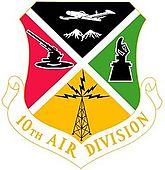
The Lockheed F-94 Starfire was a first-generation jet powered all-weather, day/night interceptor of the United States Air Force. A twin-seat craft, it was developed from the Lockheed T-33 Shooting Star trainer in the late 1940s. It reached operational service in May 1950 with Air Defense Command, replacing the piston-engined North American F-82 Twin Mustang in the all-weather interceptor role.

Alaskan Air Command (AAC) is an inactive United States Air Force Major Command originally established in 1942 under the United States Army Air Forces. Its mission was to organize and administer the air defense system of Alaska, exercise direct control of all active measures, and coordinate all passive means of air defense. In addition, the command also supported Strategic Air Command elements operating through and around Alaska. It was redesignated Eleventh Air Force on 9 August 1990 and, concurrently, status changed from a major command of the United States Air Force to a subordinate organization of Pacific Air Forces.

Aerospace Defense Command was a major command of the United States Air Force, responsible for continental air defense. It was activated in 1968 and disbanded in 1980. Its predecessor, Air Defense Command, was established in 1946, briefly inactivated in 1950, reactivated in 1951, and then redesignated Aerospace rather than Air in 1968. Its mission was to provide air defense of the Continental United States (CONUS). It directly controlled all active measures, and was tasked to coordinate all passive means of air defense.

Ladd Army Airfield is the military airfield located at Fort Wainwright in Fairbanks, Alaska. It was originally called Fairbanks Air Base, but was renamed Ladd Field on 1 December 1939, in honor of Major Arthur K. Ladd, a pilot in the U.S. Army Air Corps who died in a plane crash near Dale, South Carolina on 13 December 1935.

The 11th Air Division was an air division of the United States Air Force. It provided for the air defense of northern Alaska and supervised base operations at major and minor installations in that area. It furnished detachments at Ice Station Alpha, Drift Station Charlie, and Drift Station Bravo (T-3), in the Arctic Ocean."

The 31st Air Division is an inactive United States Air Force organization. Its last assignment was with Air Defense Command, assigned to Tenth Air Force, being stationed at Sioux City Municipal Airport, Iowa. It was inactivated on 31 December 1969.

The 39th Air Division is an inactive United States Air Force organization. Its last assignment was with Fifth Air Force at Misawa Air Base, Japan. It was inactivated on 15 January 1968.

The 101st Air Refueling Wing is a unit of the Maine Air National Guard, stationed at Bangor Air National Guard Base, Bangor, Maine. If activated to federal service with the United States Air Force, the 101 ARW is operationally-gained by the Air Mobility Command (AMC).

The 103rd Airlift Wing is a unit of the Connecticut Air National Guard, stationed at Bradley Air National Guard Base at Bradley International Airport, Windsor Locks, Connecticut. If activated to federal service with the United States Air Force, the 103 AW is operationally-gained by the Air Mobility Command (AMC).

The 343d Wing is an inactive United States Air Force unit. Its last assignment was with Pacific Air Forces at Eielson Air Force Base, Alaska, where it was inactivated on 20 August 1993. The unit was formed at Eielson as the 343d Composite Wing and activated in October 1981 to replace the 5010th Combat Support Group. It operated both fighter and forward air control aircraft. In 1991, it also became the administrator for periodic Exercise Cope Thunder operations, which moved to Alaska from the Philippines after the eruption of Mount Pinatubo resulted in the evacuation of units from Clark Air Base When the wing was inactivated, it was replaced at Eielson by the 354th Fighter Wing.

The 18th Aggressor Squadron is a subordinate unit of the 354th Fighter Wing based at Eielson Air Force Base in Alaska, and flies the Block 30 General Dynamics F-16C/D aircraft.

The 65th Air Division is an inactive United States Air Force organization. Its last assignment was with United States Air Forces in Europe, assigned to Seventeenth Air Force, being stationed at Lindsey Air Station, Germany. It was inactivated on 30 June 1991.

Tatalina Air Force Station is a closed United States Air Force General Surveillance Radar station. It is located 13 miles (21 km) west-southwest of McGrath, Alaska.
Naha Air Base, formally known as the Kōkū Jieitai Naha Kichi (航空自衛隊那覇基地), is an air base of the Japan Air Self-Defense Force formerly under control of the United States Air Force. It is located at Naha Airport on the Oroku Peninsula in Naha, Okinawa, Japan.

The 18th Operations Group is the operational flying component of the United States Air Force 18th Wing, stationed at Kadena Air Base, Okinawa, Japan.

Portland Air National Guard Base is a United States Air Force base, located at Portland International Airport, in Portland, Oregon.

Elmendorf Air Force Base is a United States Air Force (USAF) facility in Anchorage, Alaska. Originally known as Elmendorf Field, it became Elmendorf Air Force Base after World War II.
King Salmon Air Force Station is a closed United States Air Force General Surveillance Radar station. It is located 0.4 miles (0.64 km) west of King Salmon, Alaska.
Indian Mountain Air Force Station is a closed United States Air Force General Surveillance Radar station. It is located 15.8 miles (25.4 km) east-southeast of Hughes, Alaska.

The 11th Air Control Wing is an inactive unit of the United States Air Force, last stationed at Elmendorf Air Force Base, Alaska. It was assigned to the Pacific Air Forces' Eleventh Air Force and was inactivated in 1994.


















